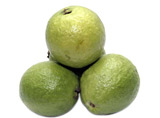 Guava is another tropical fruit rich in nutrition. With its unique flavor, taste, and health promoting qualities, the fruit easily fits in the new functional foods category, often called King of fruits.
Guava is another tropical fruit rich in nutrition. With its unique flavor, taste, and health promoting qualities, the fruit easily fits in the new functional foods category, often called King of fruits.
Nutrition
Guavas are rich in dietary fiber and vitamin C, with moderate levels of folic acid (nutrition table). Low in calories per typical serving, and with few essential nutrients, single common guava (P. guajava) fruit contains 257% of the Daily Value (DV) for vitamin C (table). Nutrient content varies across guava cultivars. Although the strawberry guava (P. littorale var. cattleianum) has only 39% of the vitamin C in common varieties, its content in a 100-gram serving (90 mg) still provides 100% of the DV.
Production
In 2016, world production of guavas was 46.5 million tonnes, led by India with 41% of the total (table). Other major producers were China (10%) and Thailand (7%).
Guava production – 2016
| Country | Millions of Tonnes |
|---|---|
| India | 18.8 |
| China | 4.7 |
| Thailand | 3.4 |
| Mexico | 2.2 |
| Indonesia | 2.2 |
| Pakistan | 1.6 |
| Brazil | 1.4 |
| World | 46.5 |
Food Idea (Culinary uses)
In Mexico and other Latin American countries, the guava-based beverage agua fresca is popular. The entire fruit is a key ingredient in punch, and the juice is often used in culinary sauces (hot or cold), ales, candies, dried snacks, fruit bars, and desserts, or dipped in chamoy. Pulque de guava is a popular alcoholic beverage in these regions.
In many countries, guava is eaten raw, typically cut into quarters or eaten like an apple, whereas in other countries it is eaten with a pinch of salt and pepper, cayenne powder or a mix of spices (masala). It is known as the winter national fruit of Pakistan. In the Philippines, ripe guava is used in cooking sinigang. Guava is a popular snack in Taiwan, sold on many street corners and night markets during hot weather, accompanied by packets of dried plum powder mixed with sugar and salt for dipping. In east Asia, guava is commonly eaten with sweet and sour dried plum powder mixtures. Guava juice is popular in many countries. The fruit is also often included in fruit salads.
Because of its high level of pectin, guavas are extensively used to make candies, preserves, jellies, jams, and marmalades (such as Brazilian goiabada and Colombian and Venezuelan bocadillo), and as a marmalade jam served on toast.
Red guavas can be used as the base of salted products such as sauces, substituting for tomatoes, especially to minimize acidity. A drink may be made from an infusion of guava fruits and leaves, which in Brazil is called chá-de-goiabeira, i.e., “tea” of guava tree leaves, considered medicinal.






